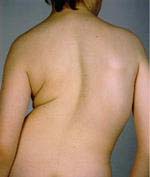
Scoliosis is the outcome of a progressive 3D deformation of the spine.
- Scoliosis affects between 2 and 3% of the population.
- Among the most severe scoliosis cases, 8 out of 10 are young females.
- Scoliosis begins in childhood or adolescence. It occurs at different ages and is categorised accordingly as an infantile, juvenile or adolescent scoliosis. It can be detected at all ages but as it is very much related to growth, it is most common in adolescence.
- In more than 80% of the cases, the real cause of scoliosis remains unknown; this is why it’s called idiopathic. There are many hypotheses being studied by researchers. Heredity and growth control mechanisms are the main focus for modern research. Whilst there is no scientific consensus on the precise cause and progression factors of idiopathic scoliosis, enough is known to improve non-surgical treatments.
If untreated, most severe scoliotic deformations have mid
and long-term consequences on:
- Vital functions: respiratory and cardiac pathology
- Locomotion: pain and mobility limitation
- Aesthetic: hunchbacked aspect and short trunk.
 |
 |
 |

